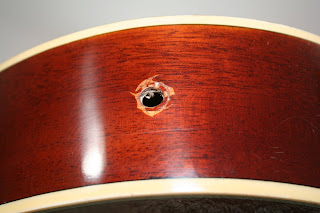
This is how it looked when it got in to my studio.
The guitar has a blow in the bottom left side that needs urgent attention but the owner doesn't care much about it because he consider it an aesthetic issue.

This is the manufacturers factory seal.

Here you can see the broken and retracted wood inside the guitar. The constant use of the cable connector in addition to the casual cable pulls looses the jack nut and produces pressure that weaken and break the wood.



In the three previous photos you can see grease from the hands, dust and dirt accumulated over the years.
Wood Repair.

First, the area to be worked must be masked with tape, then the wood is pressed from the inside to the outside of the instrument to set the loose pieces of wood with cyanoacrylate glue. After these pieces are in place several layers of cyanoacrylate glue are added to create volume until it reaches the same level of varnish.
Next Step is to reinforced the area with a thin layer of wood to compensate for the structural weakness of the hole and then drill the hole again.
The exterior is sanded to a smooth shiny surface equal to the original.

Here you can see the final result. The light colored areas are those that were reconstituted. Their varnish was lost.

To make sure that the break will not happen in the same way again, I installed a stainless steel washer wider than the factory spec and inside a lock washer.

Here you can see the stereo jack connector. The lock washer was installed inside and the smooth stainless steel washer was installed on the outside along with the nut that was used for final installation.

These are the left over pieces, a nut and the two original washers .


In the two photos above you can see the fingerboard clean with shiny frets. The frets were hand polished.

Finally I remove all the old grease giving the guitar its natural luster. This is how it looked at the end.
Perhaps on a next time the owner will give his guitar a second chance and bring it back to my workshop to correct the blow on the left side of the top.
The End















